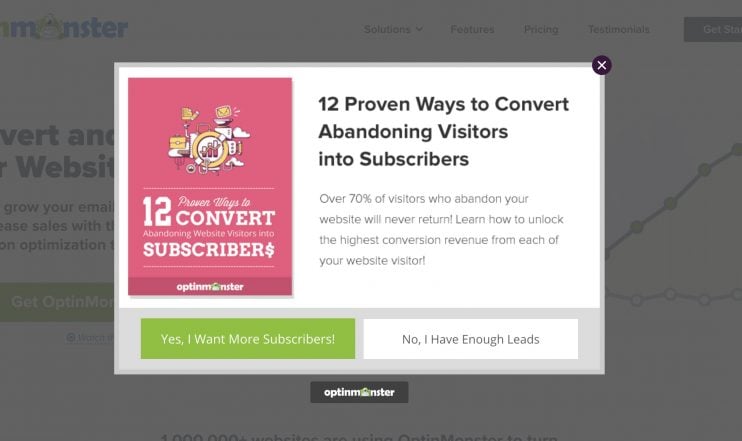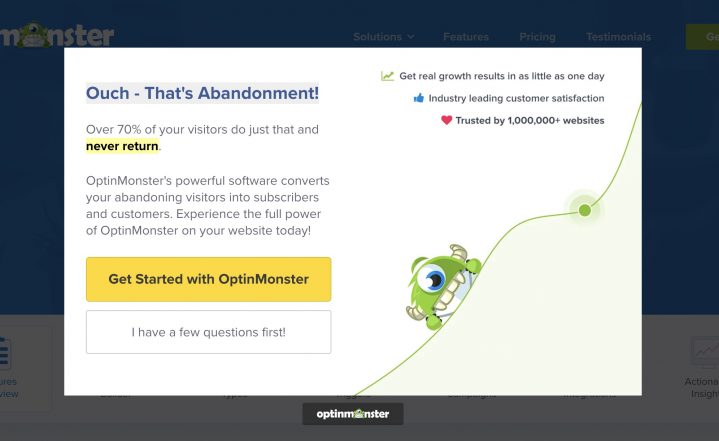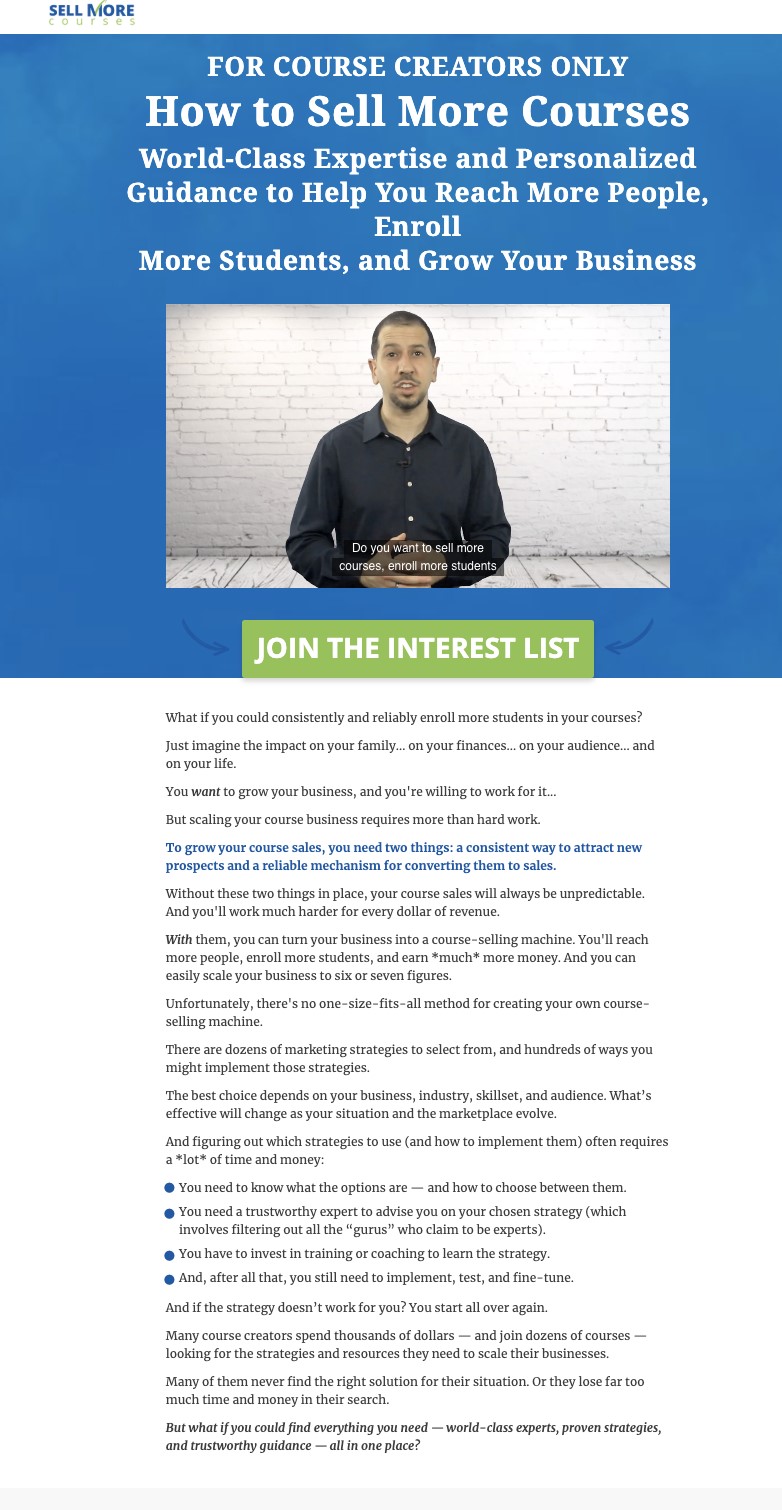How to Create a Winning Lead Generation Process for Your Business
Matthew Turner
Updated by Tara Malone
No matter what business you’re in, lead generation is the lifeblood of it. Without leads, your business simply cannot survive, let alone grow.
But generating qualified leads is something that many business owners struggle with. Many have the perception that qualified leads are the hardest ones to find.
The reality is, finding qualified leads doesn’t have to be as hard as a lot of people say, as long as you have an effective lead generation process for your business.
Many business owners and marketers don’t.
And in most cases, it’s because they don’t know what a lead generation process that attracts the right kind of people looks like.
The good news is that it doesn’t have to be this way. In fact, an effective lead generation process is easier to build than most people think.
In this article, we’ll show you how.
What is Lead Generation?
So, what exactly is a lead anyway?
A lead is someone who shows interest in one of your products. They somehow come across you (a social media message, advert, word of mouth) and ask to learn more (by submitting their information, downloading a guide, or signing up to a free trial).
Instead of buying a list and pushing your product onto them via a cold call, you pull them in with a message and they ask you for more details.
Depending on where someone is on their journey with you, there are three main types of lead:
- Marketing Qualified Lead (MQL): someone who’s engaged with your marketing but isn’t ready to receive a sales call or action.
- Sales Qualified Lead (SQL): someone who’s taken action that indicates their interest in becoming a paying customer (ie: they filled in a form asking for more details).
- Product Qualified Lead (PQL): someone who’s used your product and indicated an interest in becoming a paying customer (ie: they signed up for a free trial of your product).
Lead Generation is the process (or processes) that you take these different people through. From their first impression to converting them into a customer, it’s the journey you take them on.
Each lead generation process differs from the next.
And depending on the type of lead, you’ll likely have a different lead generation process for each.
Yet the overall journey looks the same:
- Attract: they find you/your product and visit your website
- Convert: they click on a call to action (CTA) and indicate their interes
- Close: they go to a landing page that encourages them to take action
- Delight: they give you their information in exchange for something (guide, trial, gift)
No matter what lead generation strategies you use, this is the basic blueprint that happens. All this can take place in a few minutes, or it can expand over days (or even weeks).
Ultimately, the exact lead generation process you build depends on you and your audience.
How to Establish an Effective Lead Generation Process
Our aim with this article is to give you a complete step-by-step overview of how to create an effective lead generation process.
When you finish this guide, you’ll know exactly how to build an effective lead generation process for your business.
STEP 1: Research Your Audience
The most important person throughout your lead generation process is the one you’re targeting.
- Who are they?
- What’s their biggest pain and/or problem?
- Where do they spend most of their time?
- What do they do and how do they do it?
- What language to do they use, and how do they communicate?
To build an effective lead generation process, you first need to know who it’s for. At this stage, it isn’t about what you want. Step back. Get your ideal end result out of your mind. The only aspect that matters right now is them!
We’ve written a separate guide on how to build a Customer Profile.
Many of the aspects that apply in this guide apply here, too.
It’s important to spend time researching and thinking about this. It’s the step so many businesses skip. They think only about what they want to get out of it.
This leads to ineffective content and messaging, which in turn tunes out your audience (instead of nurturing them and bringing them closer).
So, do not skip this step.
It’s possibly the most important one of all.
And it often begins by researching the people who have already found and purchased from you:
- Who’s visited your website recently?
- What search terms have they used to find you?
- If you’re using online ads already, which ones have been most effective?
- What can you learn from your current customer list?
- What do they have in common?
- Why did they buy from you (if you don’t know, ask them via a survey)
Begin with what you know. A tool like Google Analytics provides a lot of demographic information about the people visiting your website (as does Facebook Ads, if you’re currently running them). You can also dive deeper by using an SEO tool like Serped.net or Ahrefs.
Not only do these tools provide further details about who visits your site, but they give you a clearer insight into the search terms and phrases they use. This means you can figure out which questions your audience is asking.
And also learn who your main competitors are.
Knowing who your main competitors are is powerful, as it allows you to expand your research by analyzing their search terms and the content they’re currently creating.
Ask yourself:
- What platforms are your main competitors on (social media, video, podcasts, etc…)
- What content do they consistently create (blogs, guides, video, audio…)
- Which types of CTA’s do they use (and what is their sales messaging like)?
- What keywords do they target, and how is their audience finding them?
Between researching your current audience and analyzing your 3 to 5 main competitors, you’ll gather enough detail to build your ideal customer profile. From here, you can complete the rest of this process.
STEP 2: Create Impactful Content Your Audience Needs

Once you know who your audience is, you need to create impactful content for them.
The content we discuss in this step doesn’t include social media posts and adverts (that comes later). The content in this step focuses on the pillar content that you drive everyone back to:
These are the three main types of content you can create. You’ll be able to repurpose this content later in the process (into posts, emails, ads, video trailers and guides), but right now the aim is to create impactful content that helps your potential leads.
Whoever your target audience is, they have a problem. The issue here is, they may not know they have it. You have to create content that highlights the pain they feel and trigger it so they’re inspired to make changes.
From here you can show them what life could be like, offering a solution to solve their problem. And with actionable advice, tips, or steps…you can help bridge the gap and leave a lasting impact on them.
So although you need to create content that you know about and aligns with your core products and services, the most important aspect is to create the content your audience needs. Highlight their pain. Show them a solution. Give them practical steps to make instant progress.
This content is what hooks your audience.
It may not be the first impression they have of you (that comes in Step 3).
But this is the part of the process where you prove you’re the real deal!
In general, there are two main approaches to this:
- Shorter content that’s easier to digest
- Longer content that’s in-depth and VERY detailed
Brian Dean’s renowned for creating in-depth articles, but only creates a handful of these each year. Whereas someone like John Lee Dumas has built a reputation by publishing a short podcast episode each day.
Both approaches work. What matters is choosing the one that will best bring you closer toward your audience. Give them the help they need and show up in a way they need you to. From here, optimize every piece of pillar content you create for SEO using a tool like Serped.net or Ahrefs.
A piece of software like CoSchedule helps you stay organized and create a long-term strategy.
But the tools you use aren’t what matters during this stage. It’s the content you create. Whether you write impactful articles, shoot memorable videos, or record inspirational podcast episodes…all that matters is how you help solve your audience’s pain.
STEP 3: Repurpose, Distribute, and Promote Your Content on Relevant Platforms
The content you create during Step 2 will bring organic traffic, but this often takes time.
So if you want to reach more people now, you need to repurpose, distribute, and promote this content.
Repurposing
This is where you create lots of micro-content from a larger body of work. Gary V popularized this method recently, but it’s a tactic many industries have used for decades (i.e. Sports Highlights Shows).
Take this article you’re reading…
Coming in at over 5,000 words, it’s a long-form post that provides a lot of information.
The potential to repurpose this article into other pieces of content is high:
- A short podcast episode that highlights the overall process…
- A short video that does the same…
- Trailer videos that capture 30 to 60 seconds of the main video…
- Facebook posts…
- An infographic…
- An email series…
- A short online course…
- Quotes or memes (that can be shared on Instagram and Pinterest)…
- Online ads (Facebook, Google, YouTube)…
- A PDF guide…
- A PDF workbook…
This is easier to do if you create in-depth pillar content (the type Brian Dean does), but you can still do this if you share regular content (as Gary V. proves).
The point here is to:
- Produce more content and improve your reach
- Produce different content for different learning styles
Some of your audience loves to read, whereas others prefer to listen or watch. Some of them will like to set aside time to read an article in full, whereas some prefer a 3 to 5 minute overview.
Remember, your aim is to highlight their pain and show them what the solution is.
Whether you do this through a long-form article or a short video overview doesn’t matter, as long as it appeals to your audience.
Distribution
Now that you have all this extra micro-content, it’s important you share it far and wide.
- Facebook Groups (yours and those communities you’re a part of)
- Email (as an email broadcast, but also added to your existing marketing funnel)
- YouTube
- New Aggregate Sites (like Growth Hacker, Inbound and Alltop)
- Relevant Online Forums and Communities
- Relevant Reddit Threads
- Quora
There are many ways to distribute your content. It would be impossible to target every platform, so focus on the ones that will help you show up in front of your target audience. Where are they? What tools do they use to keep updated with the news? What formats do they prefer?
It isn’t just the micro-content you can distribute far and wide, either.
Take this article. As well as publishing it on this blog, we could syndicate it on:
- LinkedIn Articles
- Medium
- Facebook )
- Quora
- and potentially other people’s blogs and/or publications
This is a step so many businesses forget about. They write articles and record videos, publish it on their website, and upload to YouTube, thinking this is enough for their lead generation process.
It isn’t. If this is all you do, you’ll only capture a small percentage of potential leads. And although this part of your lead generation process can be time-intensive, there are tools and services to help:
- Repurpose.io (repurposes and distributes podcasts and videos)
- FancyHands (provides affordable assistants to implement simple workflows)
- Buffer (allows you to share, automate, and schedule your social posts)
- Edgar (a great tool for reposting messages)
Distributing your content is one of the most important parts of your lead generation process.
Promotion
Similar to distribution, it’s important that you promote your content (especially the pieces of content that convert the best). As you know, there are two main ways to promote your content:
- Organically (through social media, email)
- Paid Promotion (Facebook ads, Google Adwords,)
By repurposing your content and creating a lot of micro-content, you make it easier to build both organic and paid promotional campaigns. For organic reach, use tools like Buffer and Edgar to schedule, repost, and automate at least some of the process.
For paid promotions, the main platforms are:
- Facebook / Instagram Ads
- Google Adwords (PPC)
- YouTube Ads
But don’t forget other options such as Outbrain and the promotional features on platforms like Quora and LinkedIn. These can offer an affordable option to get your articles in front of relevant people.
Once you do, more people will come back to your site. This brings us to the next step in this lead generation process.
STEP 4: Create a Compelling Call to Action (+ Gift)
Repurposing, Distributing, and Promoting your content could be an article on its own (we could likely create an in-depth online course on the subject). The main point to remember is that a good lead generation process doesn’t just happen.
You need to create great content…and then get it in front of the right people.
So as important as your articles, videos, and podcast episodes are, don’t stop there. Think about how you can repurpose your content and distribute it far and wide. Because the more relevant people who come across your message, the better your lead generation process will become.
But only if you master this next step!
Remember that basic lead generation process from earlier?
- Attract: they find you/your product and visit your website
- Convert: they click on a call to action (CTA) and indicate their interest
- Close: they go to a landing page that encourages them to take action
- Delight: they give you their information in exchange for something..
A person’s first impression of you will often happen away from your website. If they come to your website they’re curious to learn more. And if the content you create is great, they’ll likely stick around long enough for you to invite them to take the next step.
And this next step is where your lead generation process succeeds or fails!
- What do you want them to do next?
- What single action should they take?
- Is it clear?
- As well as being clear, does the messaging entice them?
- What are you giving them?
- What big promise are you making?
At this stage, you need to create a compelling call to action (CTA). You need to give them a reason to fill in their details and take the all-important next step with you. Until they do, they won’t become a “lead”.
What is Your CTA?
A single call to action often isn’t enough. When they visit your site and read one of your articles, you need to remind them what their next step should be several times.
With a signup form like this…

And a form like this one that appears when they scroll down the page…

Or one like this that triggers when they’re about to leave the page…

A form may not be enough, either… you may need a landing page…

It’s important to remember that your soon-to-be lead doesn’t have much time and they don’t know what you want them to do next. It may seem obvious to you, but it won’t be for them.
Make it clear.
Invite them to take action several times.
Keep showing up with the offer for more help and guidance.
What “Gift” Are You Offering?
The question to ask yourself here is: Why should they take the next step with you?
What are you giving them?
As part of your CTA, what’s the gift or offer?
- An in-depth Guide / PDF
- A Webinar or Step-by-Step Training
- A Sample (that provides a sneak-peek into your core product)
- A Book
- A Free Trial Period
- A Discount or Promotion
- A Lead Quiz
- A Practical Worksheet or Template
- A Video Series
- An Email Series
- A 10 Day Challenge
- A Free Online Course
There are many gifts you could offer, so it’s important to think about what has the biggest impact on your audience. Ideally, this will align with the pillar content you create (and could be as simple as a PDF or Audio version of the article they can download).
Sometimes it won’t have a direct alignment with the article/video you create. This is fine, so long as it gives your audience what they need. Your “gift” doesn’t have to give them everything they need. But it should provide them some of the tools, advice, and guidance they’re looking for.
Between a great call to action and an enticing gift, they’ll sign up, fill in their details, and commit to the next step with you. And it’s during this next stage where the real magic happens.
Before we move on…here are some tools that may help you create a GREAT CTA and Gift:
- Sumo (offers an array of tools and plugins to capture leads with forms, landing pages, and more)
- OptinMonster (allows you to create different types of lead gen forms, pop-ups, and CTA tools)
- Convert Plus (a simple plugin that allows you to create multiple pop-up forms)
- Unbounce (a landing page builder that also gives you the ability to create pop-up forms, exit forms, and other lead gen capture features)
- Instapage (another landing page builder, which allows you to create A/B testing and experiment with different forms, pages, and styles)
- LeadPages (considered one of the best landing page builders, this also gives you access to form creators, alert bars, and other features designed to capture a lead’s details )
- Pardot (an all-in-one marketing and CRM solution, including the ability to create pages, forms, and more)
There are many other tools, software and plugins, but these are among the best available.
STEP 5: Nurture Your Lead
At this stage they have taken the next step and are officially a lead.
You have them.
The last thing you want to do now is to lose them!
This is where many businesses go wrong. They jump straight to the sale, a launch, or some other form of a sales funnel. Instead of building trust with their new lead, they focus only on turning them into a customer.
This doesn’t work, because there’s just too much competition these days.
Instead, you need to nurture your new lead with more value, help, and guidance.
There are two ways you can do this:
- An Email Funnel (that nurtures and builds trust)
- An Omnipresence Ad Campaign (using Facebook Ads, Google Adwords)
We’ve written a separate article that focuses on trust-building email sequences (click here to open it in a new tab). It’s an article we recommend you bookmark to read later, as it’s a fundamental step to success in today’s hyper-competitive online world.
The main takeaway from this step is easy to describe, though: BUILD TRUST and get TOP OF MIND.
Your aim is to share your story with your new lead, invite them to be part of it and continue to provide value. Resist the temptation to sell. Make it available to them, as some of your new leads will be ready to take action straight away.
Yet many of them won’t be.
So build a funnel and experience for them.
- Share your story
- Ask them to share their own
- Provide social proof
- Continue to highlight their pain
- And continue to show them what the solution looks like
- Bridge the gap with more articles, videos and podcasts
- Show them what the next step with you looks like
Show up often, in their inbox and in their newsfeed. Retarget them on Facebook and elsewhere on the web. Again, not with sales-focused messages, but with nurture-building videos, guides, articles, and posts.
STEP 6: Score Your Lead
We’re getting to the stage of your lead generation process where you turn good into GREAT.
This links with the previous step, because a large part of building trust with your new lead is to give them relevant content. For a long time, marketers had to push the same messages on everyone.
They needed to create more generalized content.
Content that would help and appeal to the masses.
Not anymore. Today, you can build sophisticated marketing systems so you only deliver what they need when they need it. This is how you transform your lead generation process into a money-making machine.
So, how do you do this?
An Introduction to Lead Scoring
With software like Infusionsoft and Active Campaign (and to a lesser extent, ConvertKit), you can score your leads based on the actions they take.
Much of this takes place inside your nurture funnel. But it can involve your retargeting ads too.
- As you ask them questions, “tag” and segment them accordingly.
- Add 3 points to their score if they click on an article.
- Give them 10 points if they watch a training video.
- If they click on one of your sales pages, that’s 20 points.
- And if they schedule a complimentary call…that’s 40 points.
You can build a scoring system however you like. The point is that before long you can create different funnels for different leads, based on:
- Their engagement
- Where they are in the sales cycle
- Their location, job title, industry
- The type of content they consume
The possibilities are almost endless. You can go as deep as you like. But even if you keep your lead generation process simple, you enhance your ability to provide relevant information when they need it.
This is powerful.
Most businesses do not do this.
Not because they can’t, but rather they’re too busy to (or don’t wish to go the extra mile).
Yet it’s scoring your lead and going that extra mile which sets you apart. It allows you to not only create an effective lead generation process… but one that serves you and them in a big way.
STEP 7: Analyze The Data
If you commit to these first six steps, you’ll produce a lead generation process that’s better than most of your competitors. Yet it’s these final three steps that allow you to build the best one YOU can.
Because whatever you create, it will never be perfect. There’s always room for improvement. There’s always a part of the lead generation process that can be more effective.
Yet the only way you will find this out is if you track and analyze the data.
- Which articles, videos, and podcasts perform the best and rank the highest in Google?
- Which ads convert the best, and which have the highest reach when you consider how effective traffic distribution strategies can enhance ad performance?”
- What social media platforms bring the most leads and what posts are shared the most?
- Which lead magnets and “gifts” convert the most leads?
- Which signup forms have the best performing copy, and which landing pages have better bounce rates?
If you don’t know the answers to these questions, you’ll likely not understand which parts of your lead generation process to focus on.
Weekly…monthly…quarterly…a huge part of an effective lead generation process includes the tracking and analysis of data.
You can’t track everything, but you do need to set some core KPIs (key performance indicators). Once you have, create a process within your lead generation process to track each article, video, and podcast.
You’ll want to track and analyze your ads, the social media platforms you use, and the open rates and engagement of your nurture funnel
This is possibly the hardest part of the whole lead generation process, as it’s also difficult to know what metrics to track and analyze.
So bring it back to your audience,
Which metrics will help you deliver a better experience to them?
Then set those KPIs and build a regular process to track and analyze. From here you can continuously improve your lead generation process over time. Whatever you create, it won’t ever be perfect. It doesn’t need to be. The point is to improve it as often as you can.
Just going through this process sets you apart from most other businesses in your space.
STEP 8: Bring in Your Sales Team

This step isn’t as important for some businesses, yet for others it’s one of the most vital parts of the whole lead generation process.
Does your sales team have the details they need?
It’s all great to create an effective lead generation process that brings in new leads each day. You may have the best content in your industry, and an email funnel that builds trust and rapport. But if you rely on a salesperson and/or team to turn a lead into a customer…it means little if they’re not in the loop.
They likely don’t need all the information you and your marketing team have. They don’t need access to the complete lead generation process (and may not need to know how it all works or what’s involved).
What they do need to know is…which leads are ready to take action!
Ideally, your sales team should:
- have access to a specific lead’s lead score.
- see what actions they’ve taken, and how they’ve engaged with your content.
- be able to see their social media profiles and other important details.
- know what products they have shown an interest in.
No matter how good your lead generation process is, you need to judge it on the sales it brings in.
A lead is great, but at some point they need to become a customer.
If you don’t rely on a sales team to do this, you can skip this step.
But if you do, you may find it’s the step that has the single biggest impact on the whole process.
STEP 9: Review Your Lead Generation Process
The final step of your lead generation process is to regularly review it.
- Once per year?
- Every six months?
- Every 90 days?
There’s no right answer. Whatever works for you and your team is the only answer you need. What matters is that you review your lead generation process often.
- Where are the holes?
- Which parts of the process perform best, and which ones perform worse?
- What feedback are you getting from customers and from your team?
- What’s the data telling you?
There’s no such thing as the perfect lead generation process. There’s always room for improvement, and as with most things in business, it will evolve over time based on you, your team, and your audience.
So once you get your lead generation process up and running…set a time in your calendar later in the year to review, amend, and improve.
Those businesses that do are the ones with the most effective lead generation processes.
Start Building an Effective Lead Generation Process for Your Business
We’ve covered a lot of ground, and you should now have a clearer understanding of why a lead generation process is essential for your business.
Without regular leads coming in, you’ll have to commit more and more time to finding them. This is time you cannot spend growing, scaling, or improving your business.
If you don’t have an effective lead generation process, you’ll remain stuck inside your business doing work you shouldn’t be doing.
So how do you start building your lead generation process?
It all starts with getting to know who your audience is.
If you don’t have a Customer Profile or Avatar, now is the time to create one.
From there, use this article to go through the entire process. Before long, you too will have a lead generation process that goes the extra mile.